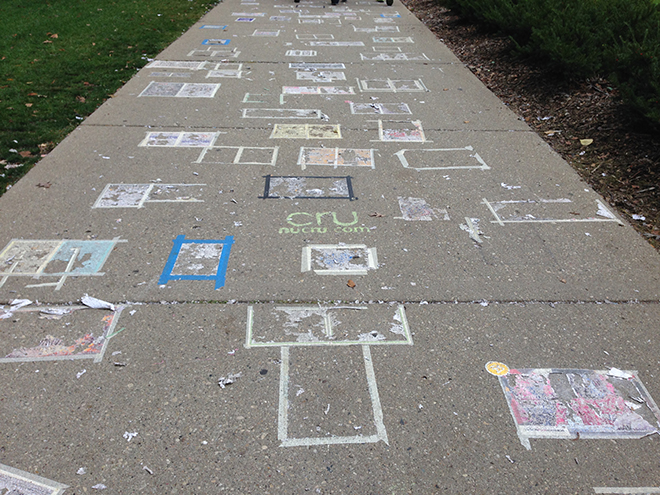Performance Testing
Final Prototype

Background
Walk around Northwestern's campus and you might notice something strange--thousands of paper flyers taped to the sidewalks. To advertise an upcoming event, student groups will often tape a hundred flyers to the ground with information about it. This process, known as flyering a campus tradition, but it's also time-consuming, ineffective, and wasteful.
Phase I: Ground Glue, The Class Project
Our clients wanted a more efficient method of flyering that would be easier to use and more versatile while still highly visible and cost-effective. I steered my group towards trying to make a product that was more sustainable as well.
After brainstorming, sketching, performing cost analyses, and discussing pros and cons of different ideas, we decided to pursue an environmentally-friendly wheat paste glue. Wheat paste is easier to use than tape, less expensive, and elimates the need for so much wasted tape.
I met with professors about biodegradable adhesives and researched different recipes for wheat paste. We made four different variations--each with different proportions of water, flour, and sugar. We tested each recipe by using it to paste a flyer to the ground and seeing how much of the flyer (what percentage of the original area) was present after certain time intervals.
We performance tested several different application methods as well and decided on a wide brush that would allow users to apply the glue in one stroke. We ultimately presented our clients with a final prototype: the glue recipe, the ingredients, and the bucket and wide brush for application.
Phase II: Associated Student Government Project
Although our prototype worked well and solved the problem our clients presented us with--improving the flyering process--it didn't get at the root of the real issue. Even without the tape, flyering is wasteful, and I suspected it wasn't very effective. I brought the issue my committee on our Associated Student Government and started and led the Sustainable Advertising Project Team.
I recruited five other members of the committee to join my new project, and we began by researching: looking at peer institutions, investigating current advertising methods at NU, and examining the role of flyering at our school through surveys and conversations with administrators and student groups. We came up with some interesting data, including the following key points:
- None of the 16 peer institutions we looked at allowed students to tape flyers to the ground.
- On a typical day, there are approximately 4,180 flyers taped to Northwestern's sidewalks, nearly two-thirds of which are weathered past the point of legibility.
- Most students do not read flyers taped to the ground, and hardly any students go to events they only hear about from ground flyers.
Flyering is wasteful and ineffective, and based on what we found, we decided that it doesn't need to be made easier; it needs to be replaced. After holding focus groups, surveying more students, and meeting with campus start-ups, we determined that the easiest and most effective way to spread information is through existing social media platforms that most student groups already use. I presented my case to our student senate, who then voted that ASG would no longer use flyering in its own advertising. We wrote a no-flyering pledge, which my project team is currently sending out to student groups to sign.